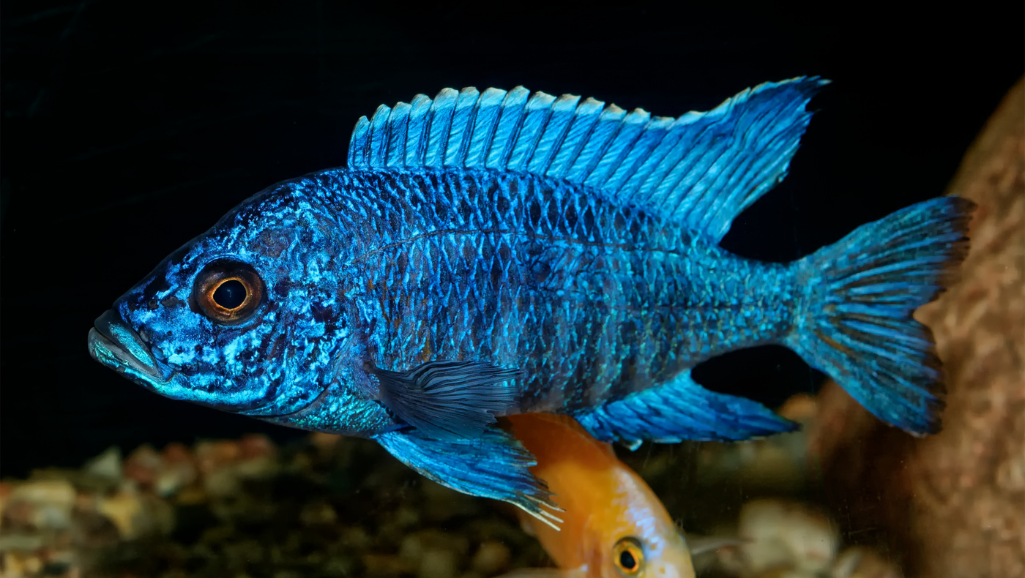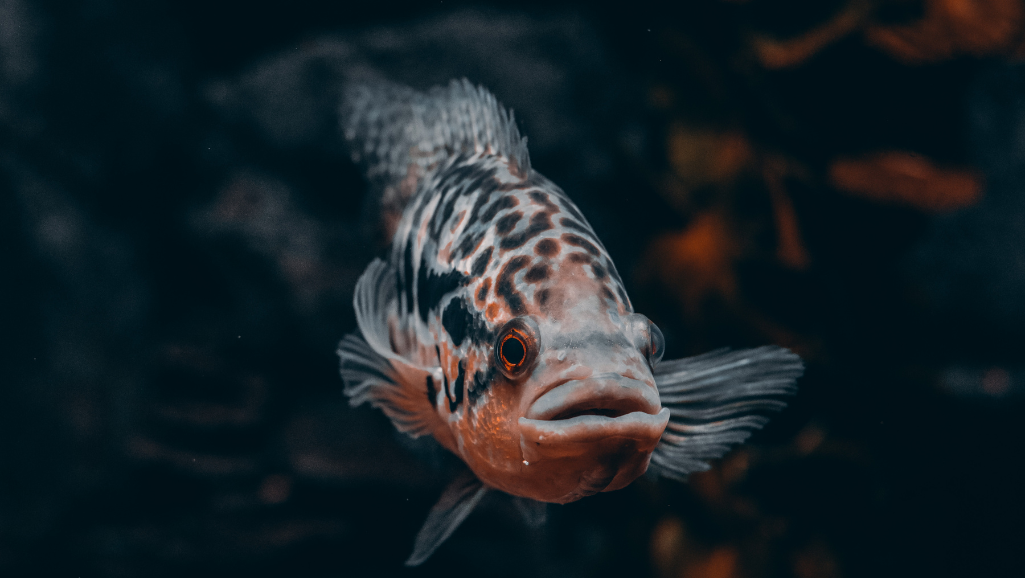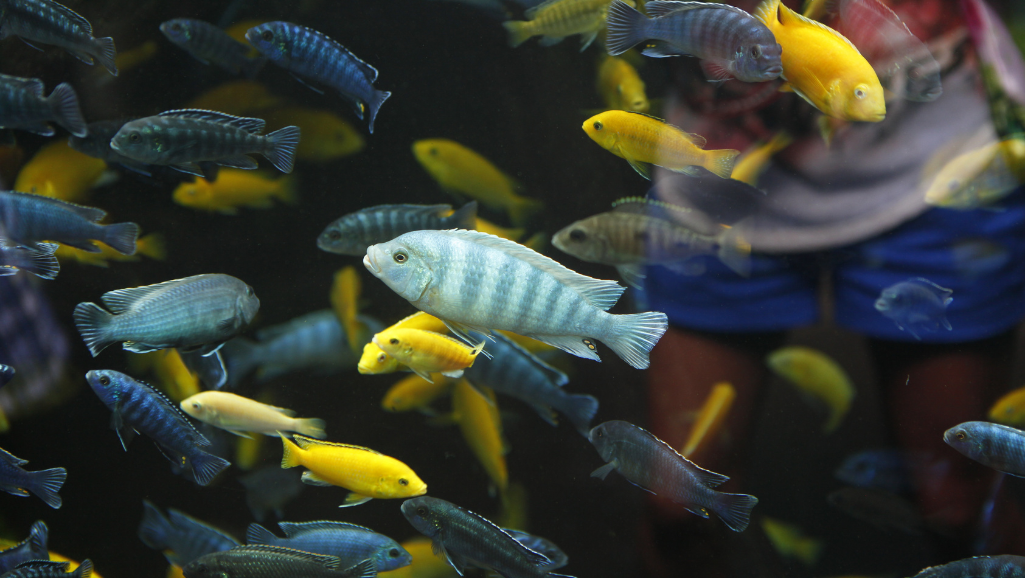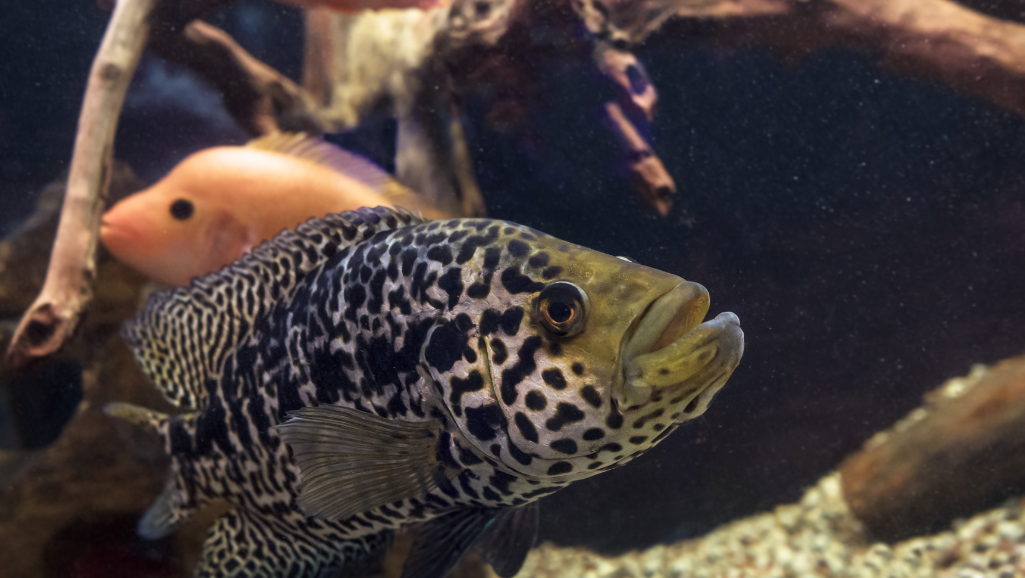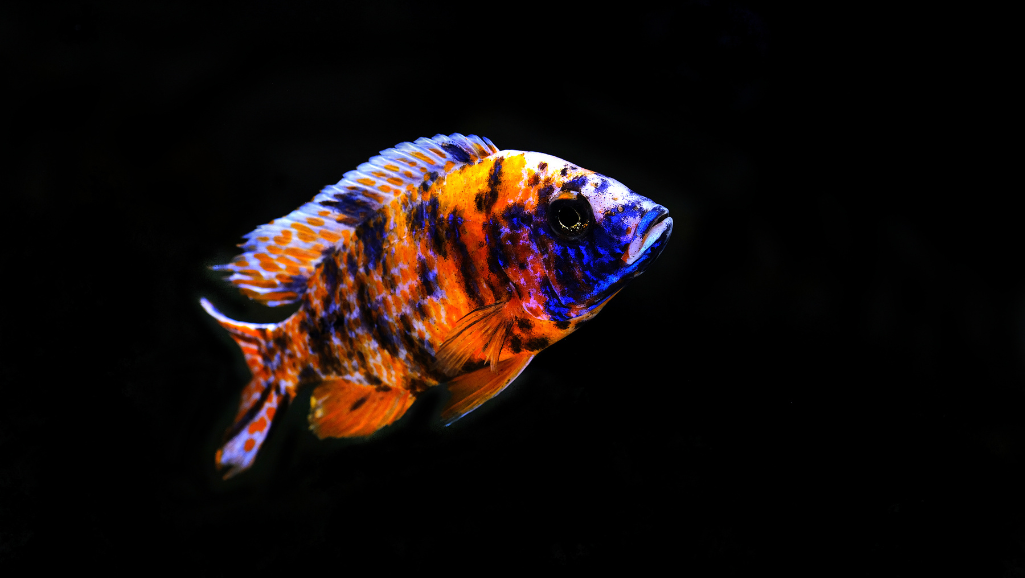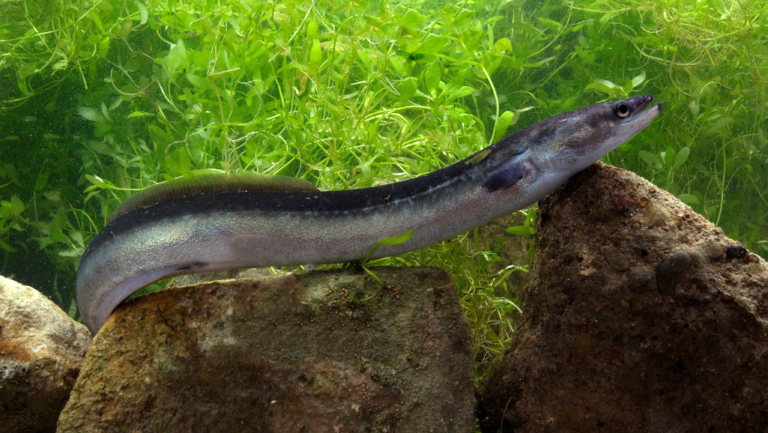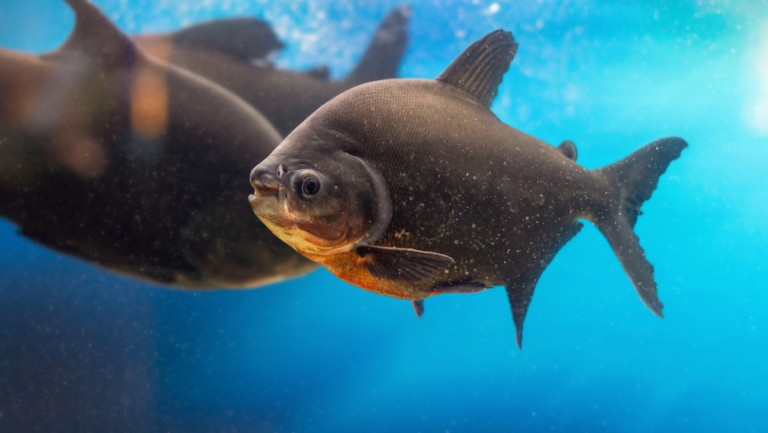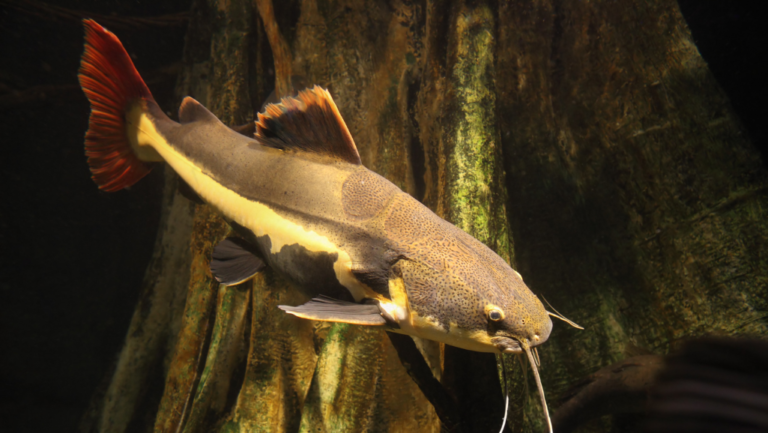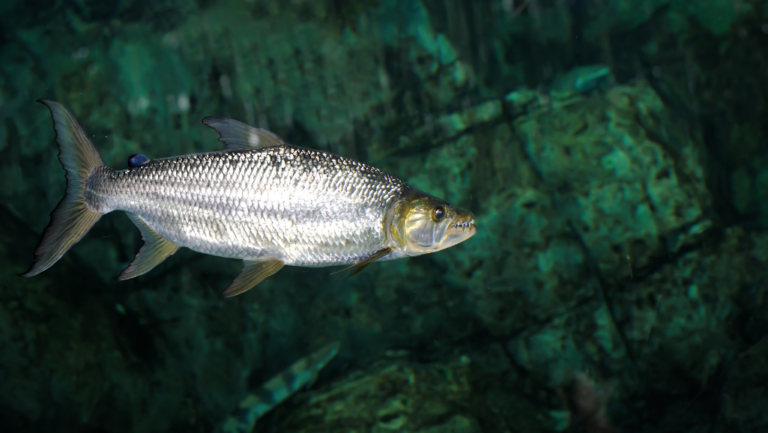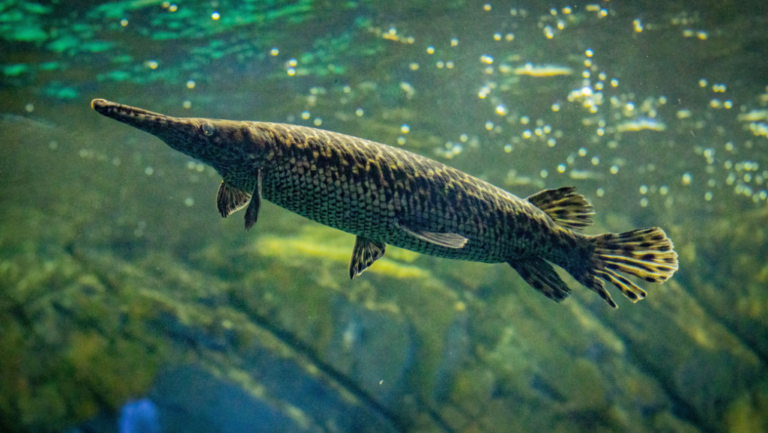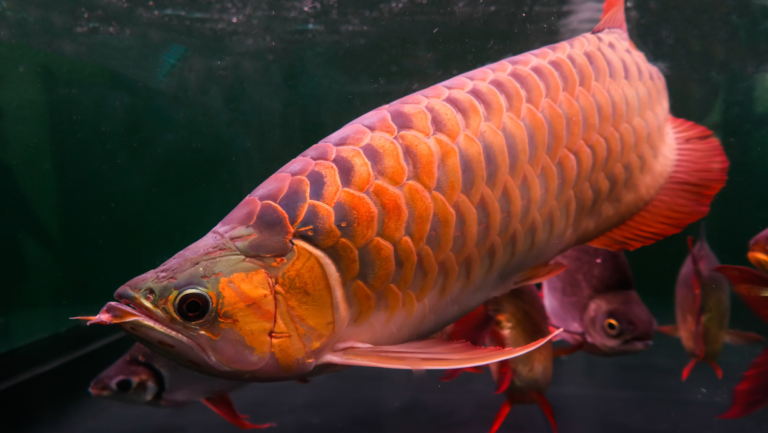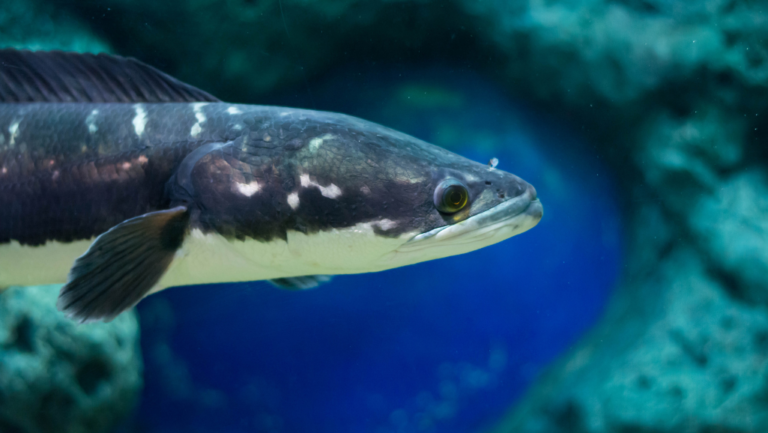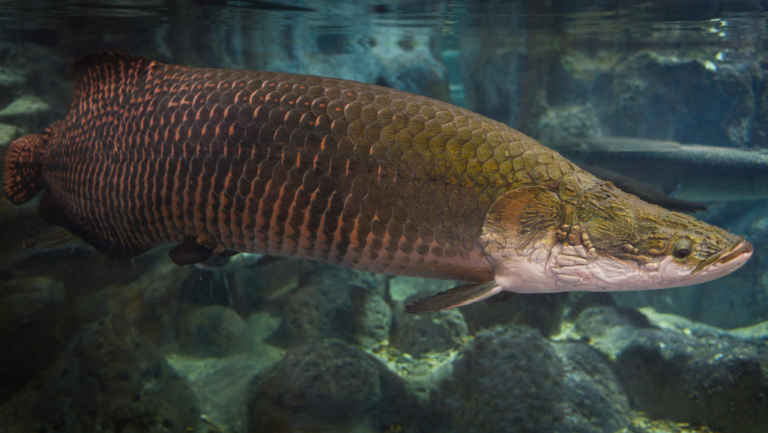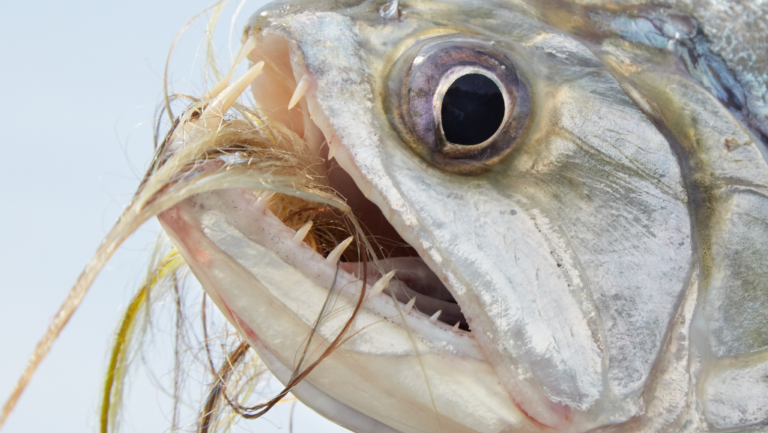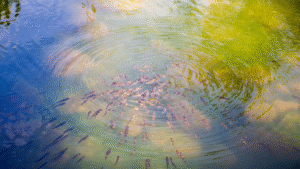The Jaguar Cichlid, known as Parachromis managuensis, is loved for its striking looks and size. It’s a freshwater aquarium favorite. Found in Central America, it’s now popular worldwide, including in Florida and Singapore. Its vibrant colors make it a standout among exotic fish.
These fish need lots of space and can be quite territorial. A tank of at least 75 gallons is recommended for one. But, bigger tanks are better for their full growth. Keeping the water right, changing it often, and feeding them well are key to their care.
Key Takeaways
- An adult Jaguar Cichlid necessitates a minimum tank capacity of 75 gallons, with 100-125 gallons being ideal.
- To accommodate their mature size, Jaguar Cichlids require ample room to grow, reaching up to 16 inches in length.
- For peak health, the water temperature should stay within a range of 75°F to 82°F, replicating their natural habitat conditions.
- Implementing a rigorous filtration system capable of cycling through the aquarium’s volume at least 10 times per hour is critical for a Jaguar Cichlid tank.
- Engage in habitual water changes, approximately 20-30% weekly, to ensure the water quality is conducive to the Jaguar Cichlid’s well-being.
- Bear in mind that these fish possess distinct health requirements and are prone to ailments such as Ich and Fin Rot, requiring attentive observation.
- With a life expectancy of around 15 years, Jaguar Cichlids are a long-term commitment for any aquarist.
Introduction to Jaguar Cichlids
The Jaguar Cichlid is a stunning fish in the fishkeeping world. It’s known for its bright colors and lively personality. Found in Central America, like Honduras and Costa Rica, it’s a favorite among aquarium fans. Known as ‘Cichlasoma managuense’, it can live in many water types, showing its adaptability.
Overview of the Species
Jaguar Cichlids have long bodies and spiny fins. Their dorsal and anal fins are very showy. They have a special jaw and sharp teeth for hunting, which also makes them a bit aggressive. This is why they’re best for experienced fish keepers.
Natural Habitat and Range
In their natural home, Jaguar Cichlids live in murky lakes and rivers. They like cloudy, rich waters where they can hunt well. Their strong nature lets them survive in different places, but they can also harm other ecosystems. For more info on caring for them, check out this guide on fishkeeping.
Knowing how Jaguar Cichlids behave and what they like in their habitat is key. This knowledge helps keep them healthy and happy in their tanks.
Essential Tank Requirements
Understanding Jaguar Cichlid care means knowing their natural habits and habitat needs. These aggressive fish species need specific tank conditions to do well in a freshwater aquarium.
Tank Size and Shape
Jaguar Cichlids are big and territorial, so they need lots of space. For one adult, a tank of at least 125 gallons is recommended. For a pair, 150 gallons is the minimum. Long tanks are better than tall ones to match their swimming habits.
Water Quality and Parameters
- Temperature: Keep the water between 74°F and 82°F to match their Central American home.
- pH Levels: The pH should be between 7.4 and 8.7, slightly alkaline.
- Water Hardness: Aim for 178.57 ppm to 267.86 ppm (10-15 dGH) to mimic their native waters.
Keeping the water quality consistent is vital for Jaguar Cichlids. Use strong filters like canister filters to handle waste and keep the water clear. Regular testing and upkeep are essential to keep the water perfect, as Jaguar Cichlids can quickly change it.
Adding these Jaguar Cichlid care tips to your tank setup helps mimic their natural habitat. This promotes healthy, stress-free living for them. It also helps keep your freshwater aquarium stable, ensuring all fish thrive.
For more tips on creating great habitats for other cichlids, check out AquaJoy. They offer detailed advice on cichlid care and diversity.
Ideal Tank Mates for Jaguar Cichlids
Finding compatible tank mates for Jaguar Cichlids means knowing their natural behavior and needs. Jaguar Cichlids are among the most aggressive fish species. So, picking the right tank mates is key to keeping the peace in your aquarium.
Compatible Fish Species
Look for large, strong exotic fish that can stand up to the Jaguar Cichlid. Good tank mates include:
- Green Terror Cichlid
- Sailfin Pleco
- Texas Cichlid
- Wolf Cichlid
- Red Devil Cichlid
- Jack Dempsey Fish
- Bala Sharks
- Blue Acara Cichlids
- Convict Cichlids
These fish are tough and somewhat aggressive, making them good matches for Jaguar Cichlids. But, they need enough space and similar food to live together peacefully.
Avoiding Aggressive Situations
To keep your tank calm, avoid fights between fish. Here’s how:
- Put all fish in the tank at once to prevent fights over territory.
- Make sure there’s plenty of room and hiding spots to lower stress and aggression.
- Watch how your fish act often to stop problems before they start.
- Use a tank divider or separate tanks if fights get too bad.
With the right strategy and understanding of your fish, your tank can be a peaceful place. It will show off the beauty and energy of these exotic fish.
Feeding Jaguar Cichlids
Feeding your Jaguar Cichlid right is key to their health and long life. These fish need a special diet to stay vibrant in your aquarium.
Nutritional Needs and Diet Options
Jaguar Cichlids love meat, needing lots of protein for their big bodies and lively nature. They should eat live or frozen foods like tadpoles and crickets. But, avoid giving them beef heart because it’s too fatty.
- High protein diet essentials: Incorporate specially formulated pellets or flake foods that cater to carnivorous fish.
- The apt blend of natural food and commercial feeds ensures they receive all essential nutrients without the unhealthy fats.
Start them on this diet early. It helps them stay healthy and avoid diet-related problems.
Feeding Frequency and Quantity
Feed them every day, making sure they eat it all in a few minutes. This stops food from rotting and spoiling the water. Good feeding keeps them healthy and colorful.
- Mornings are often the best time to feed, as it provides them with energy throughout the day and helps maintain a routine.
- Monitor their feeding habits closely; adjustments might be necessary as they grow and their appetite increases.
Feeding your Jaguar Cichlid right keeps them healthy and your tank balanced. Regular feeding stops water quality problems, making a better home for your fish.
Breeding Jaguar Cichlids
The Jaguar Cichlid is a stunning South American cichlid that captivates with its beauty and unique breeding habits. These exotic fish require specific conditions to reproduce successfully. Let’s explore their breeding habits and the care needed for their fry.
Breeding Behavior and Conditions
Jaguar Cichlids start breeding when they reach about 4 inches. They often form pairs from communal groups. To breed, the tank’s temperature should be between 80-82°F and the fish should eat high-protein foods.
The female lays up to 1500 eggs on a clean flat rock. The male then fertilizes them. After fertilization, both parents protect their eggs fiercely. Setting up a dedicated breeding tank is recommended to reduce stress.
Caring for Fry
After hatching, the fry rely on their yolk sacs for nutrition. They start swimming freely in about a week. It’s important to feed them nutrient-rich fry foods.
Keeping the fry tank water clean is essential for their survival. The water should have a pH of 7.0 to 8.7 and a dH of 10-15. For more information on raising similar species, visit AquaJoy Life.
Meeting the unique breeding needs of Jaguar Cichlids can make your aquarium thrive. With the right care, breeding these South American Cichlids can be rewarding. It adds vibrancy and life to your aquarium.
Health and Common Issues
Keeping Jaguar Cichlids healthy in your freshwater aquarium is key. You need to watch them closely and take good care of them. Even though these exotic fish are strong, they can get sick like any other aquarium fish.
Signs of Stress and Illness
Jaguar Cichlid diseases show up in different ways. Look for odd swimming, color loss, less eating, or body spots. Changes in how they act can mean they’re sick and need help fast.
For more on keeping fish healthy, check out Texas Cichlid care. It has tips similar to what you need for Jaguar Cichlids.
Preventative Care and Treatments
Keeping your aquarium clean is very important. Check the water often and change it when needed. This helps stop problems like Ich and fin rot, which Jaguar Cichlids often face.
If a fish gets sick, put it in a separate tank right away. Use the right medicine, but only after a vet says it’s okay. With the right care, these fish can get better.
Looking after Jaguar Cichlids well means they live longer and look better. Watch the water and act fast if you see any problems. This way, your aquarium will be a great home for these amazing fish.
Conclusion and Additional Resources
Keeping Jaguar Cichlids is rewarding but needs a lot of knowledge and effort. They can grow up to 14 inches, so a big tank of at least 100 gallons is needed. It’s important to keep the water quality right, with a pH of 7.0 to 8.0 and a temperature of 75 to 82°F.
Even though Jaguar Cichlids are aggressive, knowing how to care for them can make a big difference. Adding invertebrates to the tank can also help, as they are important for young Jaguar Cichlids.
Recap of Key Care Guidelines
For those who love fishkeeping, remembering these care tips is key. A good home for a Jaguar Cichlid needs lots of space and the right water. It’s also important to choose tank mates carefully to avoid fights.
It’s also important to think about the impact Jaguar Cichlids have on local ecosystems. This is true, even if they are kept in tanks.
Further Reading and Reference Links
There’s always more to learn in fishkeeping, and Jaguar Cichlids are no exception. This article has covered the basics, but there’s more to explore. Reading about South American cichlids and talking to other fishkeepers can help you learn more.
Sharing knowledge and experiences with others can deepen your understanding of Jaguar Cichlids. It makes their care even more rewarding.
